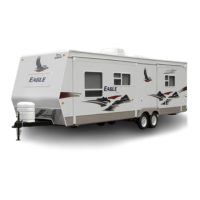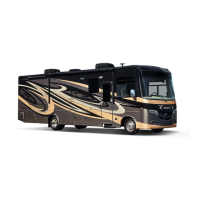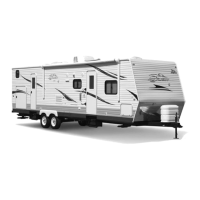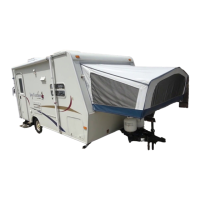SECTION 13 – EXTERIOR CLASS C MOTOR HOME
13 - 2
Gravel roads should be avoided. Anti-freeze, gasoline or washer solvents if spilled
on the painted surface should be rinsed off with water immediately. Bugs and bird
droppings should be rinsed off daily.
Washing
Commercial washing should be avoided. Wash with cold water using a mild liquid
soap. Dry wiping with a dry cloth is not recommended.
Make sure the RV’s surface temperature is cool, under 90 F, and out of direct
sunlight. A shaded area is ideal for washing your vehicle as direct sunlight causes
water spotting. Use a mild soap or detergent. Most auto care stores will carry a car
wash shampoo.
Try to avoid combination wash-n-wax products as these waxes can cause build up
and are designed for smaller surfaces. Have two dedicated sponges or wash mitts:
one for the exterior walls and one for the wheels and under- carriage.
Brushes or wash mitts that are made of plastic bristles are acceptable for use on
tires and wheel wells, but are not intended for use on the exterior walls. Avoid using
such items on painted surfaces as they will damage the finish. Wash the wheels
and wheel wells first as this removes heavy dirt and debris and prevents it from
splattering on panels. Wet the entire area down to remove loose dirt and grime,
then hand wash one area at a time using your dedicated paint finish sponge or
wash mitt. Wash from the top and work your way down, rinsing frequently to
minimize grit abrasion. Follow with a final rinse of water. This process will remove
most contamination from the motor home’s surface. For stubborn stains such as
road tar or bug stains, use an ammonia based glass cleaner or a small amount of
rubbing alcohol on a damp cloth followed immediately by warm soapy water, and
rinsing with clean water. This may not dissolve the road tar, but it will loosen tar
and bug stains and remove them from the surface. Do not use solvent based
cleaners on bird droppings or tree sap as these are water based stains. They can
be dissolved using ammonia based glass cleaner, warm soapy water and a little
“elbow grease”. Once again, after removing stubborn stains immediately rinse with
clean water. Drying the motor home is just as important as washing your vehicle.
Tap and well water contain many chemicals that could water stain your RV’s finish.
We suggest using a damp natural or synthetic chamois. There are other drying
products such as lint-free micro-fiber towels that work just as well.
During cold weather
Salt and other chemicals that are spread on winter roads in some geographical
areas can have a detrimental effect on the motor home's underbody. If your
motor home is exposed to these conditions, spray the underbody with a high-
pressure hose every time you wash the exterior of your motor home.
Take special care to remove mud or other debris that could trap and hold salt or
moisture. After washing your motor home, wipe off all water drops from the rubber
parts around the slideout and doors.
NOTE: When the slideout or door is frozen, opening it by force may tear off or
crack the rubber gasket that is installed around the slideout or door. Therefore,
pour warm water on the gasket to melt the ice (wipe off the water thoroughly after
opening the slideout or door). To prevent the weather stripping from freezing, treat
it with a silicone spray.
Waxing
Wax your motor home once or twice a year, or when painted surfaces do not shed
water well.
